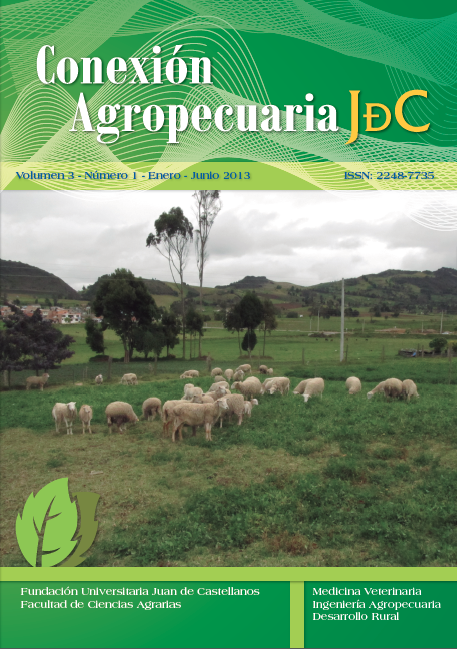Keywords:
fecal contamination, Cryptosporidium spp., gastrointestinal infection, public health, protozoan, zoonoticAbstract
Cryptosporidium has become one of the major public health problems around the world. Nowadays, Cryptosporidium has been considered as an emerging infectious disease, although it can occur as a sporadic form, the epidemic outbreaks of this zooneses are caused by drinking contaminated water; as a result of an incorrect drinking water treatment. Moreover, there are some studies related to Cryptosporidium spp. and its interaction with the land, especially, those destined to agricultural use which it has had a great impact on the public health, due to its use as wastewater for crop irrigation. In this study was possible to determine the presence of Cryptosporidium spp. in 159 soil samples which were taken from 12 different Tunja’s green parks, throughout the Ziehl Neelsen Modified staine, Spontaneous sedimentation technique. The development of this research was based on different variables such as texture, soil pH and environmental temperature. The results pointed out that some of the 80, 5% of the public parks areas were contaminated by this protozoan. Therefore, the analysis of temperature, texture and pH showed a (p <0.05) significant association between the soil texture variable and the Cryptosporidium spp. presence. Meanwhile there was not a significant association between temperature and pH. The 80.5 % evidence a high level of contaminated parks which indicates that these parks areas are an important risk factor for submission of this zoonotic diseases for public health importance. In this sense, it is necessary that the local authorities take control in order to reduce the parks contamination in Tunja.
Downloads
References
ALMEIDA, A., MOREIRA, M., SOARES, S., DELGADO, M., FIGUEIREDO, J., SILVA, E., CASTRO, A. & CORREIDA DA COSA, J. 2010. Presence of Cryptosporidium spp. and Giardia duodenalis in Drinking Water Samples in the North of Portugal. Korean J. Parasitol. 48 (1): 43-48.
ALYOUSEFI, N.A., MAHDY, M.A., MAHMUD, R. & LIM, Y. 2011. Factors associated with high prevalence of intestinal protozoan infections among patients in Sana’a city, Yemen. PLoS ONE. 6(7): e22044. Disponible en http//www.10.371/journal.pone.0022044. Accesado: 08/04/2012.
BARBONI, G., CANDI, M., VILLACÉ, M., LEONARDELLI, A., BALBARYSKI, J. & GADDI, E. 2008. Criptosporidosis intestinal en niños con HIV/SIDA. Medicina Buenos Aires 68: 213-218.
BARWICK, R., MOHAMMED, H., WHITE, M. & BRYANT, R. 2003. Factors associated with the likelihood of Giardia spp. and Cryptosporidium spp. in soil from dairy farms. Journal of Dairy Science 86: 784-791.
BOWMAN, D. 2004.Georgis parasitología para veterinarios. Octava edición. ED. Elsevier, España. 480pp.
CASEMORE, D., ARMSTRONG, M., & SANDS, R. 1985. Laboratory diagnosis of cryptosporidiosis.J. Clin. Pathol. 38: 1337-1341.
CASTRO, H. E. 1998. Fundamentos para el conocimiento y manejo de suelos agrícolas. Instituto Universitario Juan de Castellanos. Tunja.
CELIS, N. 2010. Criptosporidiasis en caninos criados en comunidades campesinas de tres distritos del departamento de Puno. Universidad Nacional Mayor de San Marcos. Tesis. Perú. 48pp.
CÓRDOBA, A., CIARMELA, M. L., PEZZANI, B., GAMBOA, M. I., DE LUCA, M. M., MINVIELLE, M., & BASUALDO, J. A. 2002. Presencia de parásitos intestinales en paseos públicos urbanos en La Plata Argentina. Parasitología latinoamericana 57 (1-2): 25-29.
DAI, X., AND J. BOLL. 2003. Evaluation of attachment of Cryptosporidium parvum and Giardia lamblia to soil particles. J. Environ. Qual. 32: 296-304.
DEL COCO, V. F., CÓRDOBA, M. & BASUALD, J. 2008. Comparación de tres técnicas de concentración de heces para recuperar ooquistes de Cryptosporidium. Acta Bioquímica Clínica Latinoamericana 42 (3): 333-337.
FAYER R, 2010. Taxonomy and species delimitation in Cryptosporidium. Experimental Parasitology 124: 90-97.
FLORES- MARGEZ, J. P, OLIVAS-ENRÍQUEZ, E., IGLESIAS- OLIVAS, J., CORRAL- DÍAZ, B., ROCHA-GUADARRAMA, Y. & GÓMEZCARBAJAL, J. 2010. Detección de Cryptosporidium parvum y Giardia lamblia en suelos irrigados con aguas residuales. En: GARCÍA, J.L., SALAZAR SOSA, E., ORONA- CASTILLO, I., FORTIS- HERNÁNDEZ, M., TREJO- ESCAREÑO, H. (Eds). Agricultura Orgánica, III Parte. CONACYT, Sociedad Mexicana de la Ciencia del Suelo A.C. Duran, México pp. 369-400. Disponible en http://www.uacj.mx/docentes/juflores/Documents/JuanPedroFMCapLibroAbonosOrganicos2010.pdf . Accesado: 07/05/2012.
GREENE, A. 2008. Enfermedades infecciosas del perro y el gato. 3ra. Edición. Intermédica. Buenos Aires. 1760pp.
KUCZYNSKA, E. & SHELTON, D. 1999. Method for Detection and Enumeration of Cryptosporidium parvum Oocysts in Feces, Manures, and Soils. Applied and environmental microbiology 65: 2820-2826.
PENG X., MACDONALD, S., MURPHY, T. & HOLDEN, N. M. 2011. The fate and transport of Cryptosporidium parvum Oocysts in the soil. In: Burcu, E., Gungor, O. (Ed.) Principles, Application and Assessment in Soil Science. InTech, Disponible en http://www.intechopen.com/books/principlesapplication-and-assessment-in-soil-science/the-fate-and-transport-ofcryptosporidium-parvum-oocysts-in-the-soil. Accesado: 22/04/2012.
PENG. X, MURPHY, T. & HOLDEN, N. 2008. Evaluation of the effect of temperature on the die-off rate for Cryptosporidium parvum Oocysts in water, soils, and feces. Applied and environmental microbiology 74 (23): 7101-7107.
POLO L., 2006. Determinación de la contaminación de los suelos de los parques públicos de la localidad de Suba, Bogotá, D.C. con nematodos gastrointestinales de importancia zoonótica. Universidad Nacional de Colombia. Tesis. Bogotá - Colombia. 135pp.
QUAH J. X., AMBU, S., LIM, Y.A., MAHDY, M. A. & MAK, J. W. 2011. Molecular identification of Cryptosporidium parvum from avian hosts. Parasitology 138: 573-577.
SOLARTE, Y., PEÑA, M. & MADERA, C., 2006. Transmisión de protozoarios patógenos a través del agua para consumo humano. Colombia Médica 37 (1). Disponible en http://colombiamedica.univalle.edu.co/index.php/comedica/article/view/415/1101. Accesado: 22/04/2012.
VERGARA, C. & QUILEZ, J., 2004. Criptosporidosis: una zoonosis parasitaria. Revista MVZ Córdoba 9 (1): 363-372.
ZANARO, N. & GARBOSSA, G. 2008. Cryptosporidium: cien años después. Acta Bioquím Clín Latinoam 42 (2): 195-201.





